Bees, wasps, yellow jackets and hornets are all considered pollinators and very important for the environment and our survival. They are directly or indirectly responsible for pollinating 1/3 of the products humans eat. Therefor a live and let live attitude would be preferred when dealing with pollinators. When they are outside pollinators should be allowed to come and go about their very important business.
Reactions to stings: If you are stung by a bee or wasp most people will have a local reaction but this doesn’t mean you are allergic to the venom. Bees, yellow jackets, and wasp venom is different, therefore having a severe reaction to a wasp sting does not mean you will have the same reaction to a bee sting. Some people have more serious allergic reactions. People with known systemic allergic reactions should consult with their physician to obtain an Epi-PenTM or Ana-Guard Sting KitTM to carry with them at all times.
Flying insect sting risks:
- Allergic reaction (occasionally may be fatal)
- Infection (more common)
General Treatment for a bee, wasp, yellow jacket or hornet stings:
- Flying insects leave behind a stinger attached to a venom sac. Gently scrape it out with a blunt-edged object, such as a credit card or dull knife. Do not try to pull it out as this may release more venom.
- Wash the area with soap and water and repeat several times during the day until the skin is healed.
- Apply a cold or ice pack wrapped in cloth; 5 mins on, 5 mins off.
- Create a paste with baking soda and water and apply to the sting site. Leave it on 15 – 20 minutes.
- Take acetaminophen for pain.
Other remedies for pain and itch:
- Apply ice, vinegar, honey, meat tenderizer or medicated ointment.
- Apply a tiny amount of household ammonia to the sting site. Most over-the-counter insect remedies contain ammonia.
- Take an over-the-counter antihistamine, if approved by your physician. Follow dosage guidelines.
Symptoms may occur within 10-20 minutes up to 20 hours later.
Local, nonallergic reactions
- can last up to a week
- Pain immediately after sting, will subside
- Burning
- Itching
- Redness, and tenderness
- Local swelling and itching (near sting site)
Allergic reaction (non-life-threatening) may include:
- hives or rash
- swelling beyond the sting site
- headache
- minor respiratory symptoms
- and upset stomach
Seek medical attention for the following symptoms: (Allergic reactions including anaphylactic shock can be fatal if untreated.)
- stung in the mouth or nose as swelling may block airways.
- swelling and blockage in the throat within minutes of being stung
- difficulty breathing
- fainting
- dizziness
- nausea or vomiting
- large areas of swelling
- persistent pain or swelling
- Painful joints
Treatment while waiting for medical attention:
- Lie down; victim should not be moved
- Lower the stung arm or leg
- Apply ice
- Do not drink alcohol
- Apply a wide cloth tourniquet between sting and the heart (should be able to place 2 fingers under bands); release after 5 minutes
How to Avoid Bee Stings
Stay away from colonies.
- Be alert for groups of flying bees entering or leaving an entrance or opening.
- Listen for buzzing sounds.
- Don't swat at them. If they land on you, gently brush them off, then walk away.
- Pour your sugary drink in a glass or cover the lid and check before drinking.
- Be especially alert when climbing, because bees often nest under rocks or within crevices within rocks. Don’t put your hands where you can’t see them.
- If you find a colony of bees, leave them alone and keep others away.
- Do not shoot, throw rocks at, try to burn or otherwise disturb the bees.
- If the colony is near a trail or near areas frequently used by humans, notify your local office of the Parks Department, Forest Service, Game and Fish Department, even if the bees appear to be docile.
Wear appropriate clothing.
- When hiking in the wilderness, wear light-colored clothing, including socks.
- Avoid wearing leather clothing; bees target objects that resemble their natural predators (such as bears and skunks), so they tend to go after dark, leathery or furry objects.
- Avoid wearing scents of any sort when hiking or working outside.
- Avoid strongly scented shampoo, soaps, perfumes, heavily scented gum, etc. If riding, avoid using fly control products on your horse with a “lemony” or citrus odor. Such scents are also known to provoke or attract bees.
Pet safety.
- When hiking it is best to keep your dog on a leash or under close control.
- A large animal bounding through the brush is likely to disturb a colony, be attacked, and bring them back to you.
Have company flying in or outside your home? The first step is to identify the pest and find out where they are coming in or locate its nesting site. You can seal the entrance depending on the species and the size of the colony. You may also spray inside the entrance before sealing it. Using a reputable pest removal company is recommended; they have the expertise to remove your pest problem safely and effectively.
Honeybees:
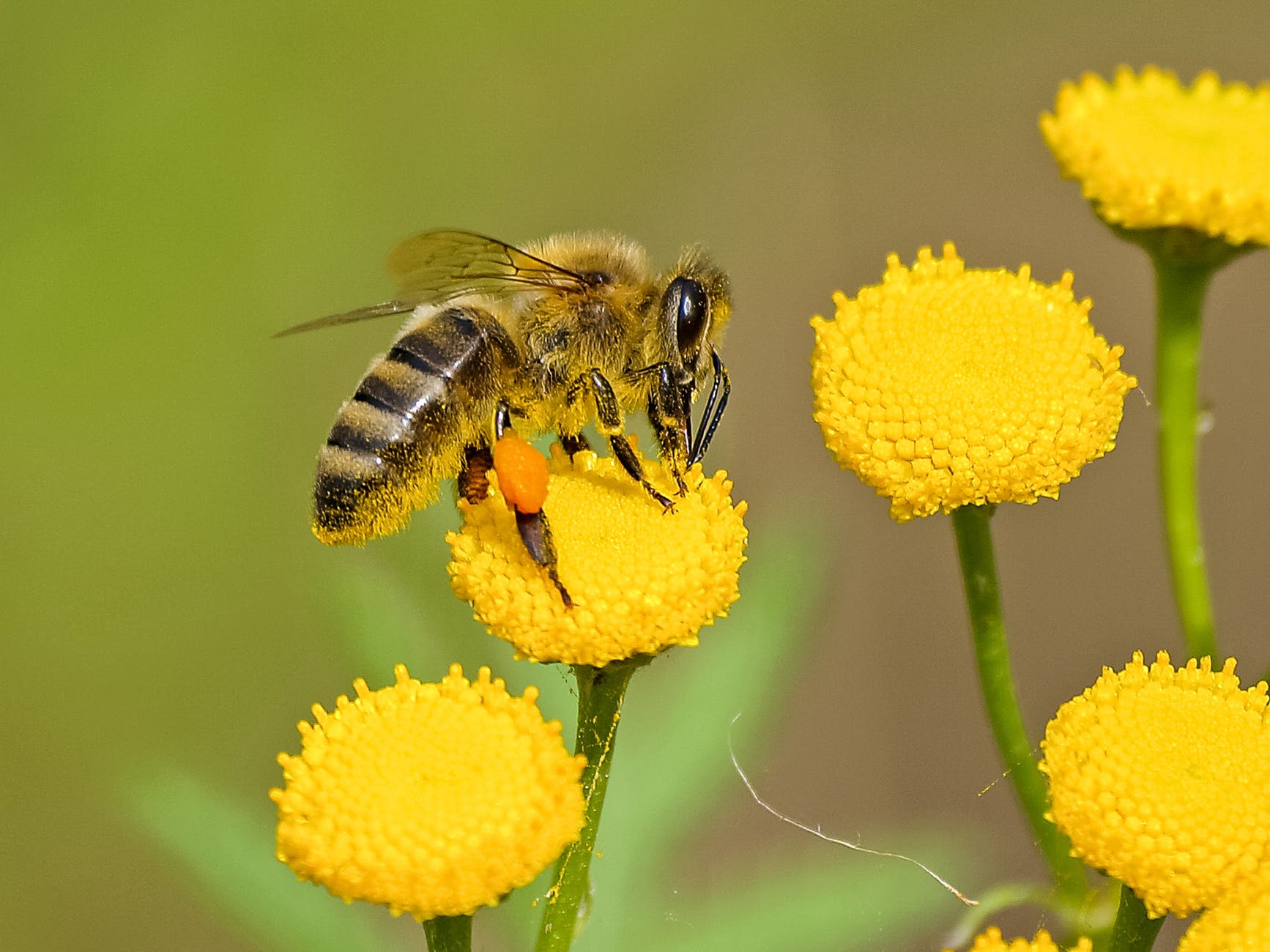
- Are the only bees that produce honey.
- Are very docile and will not sting unless provoked (stepped on or swatted).
- Will protect the immediate area surrounding their nest but will not generally chase you like yellow jackets.
- Generally nest in cavities, such as hollowed out tree trunks and bee boxes.
- A honey bee stings only once, since the barbed stinger and the attached venom sac are ripped from its body, killing it. So it stings as a last resort.
Honey bee Control
- While not a protected species, spraying and killing honey bees should be avoided if possible. However, depending on the situation killing the hive may be necessary.
- If you notice honey bees entering your home, sealing the hole may not be a good idea. The egg laying queen exudes pheromones which attracts bees to her. The worker bees come and go bringing pollen which will be processed and converted into honey for the hive. If the entrance is closed the honey bees may die in the hive leaving the honey, eggs, and brood (bee food) which will attract other pests. Therefore, a local beekeeper should be called to remove the bees, hive, and honey. They will also clean or dry the residue.
- Spraying the hive will kill the bees but leave the rest behind as well. And, if sprayed, the bees will be useless to a beekeeper.
- A beekeeper should be called only in the case of honey bees.
Honey bee swarm:

This is a natural part of the hive cycle; the hive has outgrown the nest. Therefore a group of bees, with a queen, leave the nest and look for a new home. The group is well fed, docile and waiting for its scouts to come back with their new home location. A honey bee swarm may wait in an area up to 3 days before a new home is located. It is best to leave the swarm and wait for them to move on. This is a great learning opportunity for children; if left alone they are not to be feared. If the swarm is in an undesirable location such as a school or playground where children or dogs may harass the group, call a local beekeeper to re-locate the swarm. Honey bees will not attack unless provoked.
Wasps and hornets:
- They generally nest aboveground.
- Can be aggresive but are not scavengers like yellow jackets. So they are less likely to disturb picnics.
- Try to tolerate small populations of wasps. Use preventive practices to stop them from becoming intolerable.
- Learn to tell the difference between harmful social wasps and the solitary ones that are mostly harmless and beneficial.
Social wasps make paper nests in different shapes and sizes, some of them quite visible and others hidden. The paper nest can be fully enclosed with an opening near the base, or have an open structure, depending on wasp species.
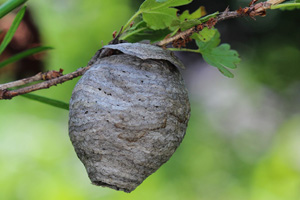
Prevention and control specific to wasps:
- Because they are also attracted to sweet food and strong scents, avoid leaving food or drink uncovered when eating outside.
- Place traps on the perimeter of your eating area
- Always look before eating or drinking outside ex: a wasp may have found its way in a pop can or food without being spotted
- Don't wear scented products like perfume and hair spray.
- Avoid walking barefoot on lawns or other grassy areas, especially in late summer when wasps are more abundant and active.
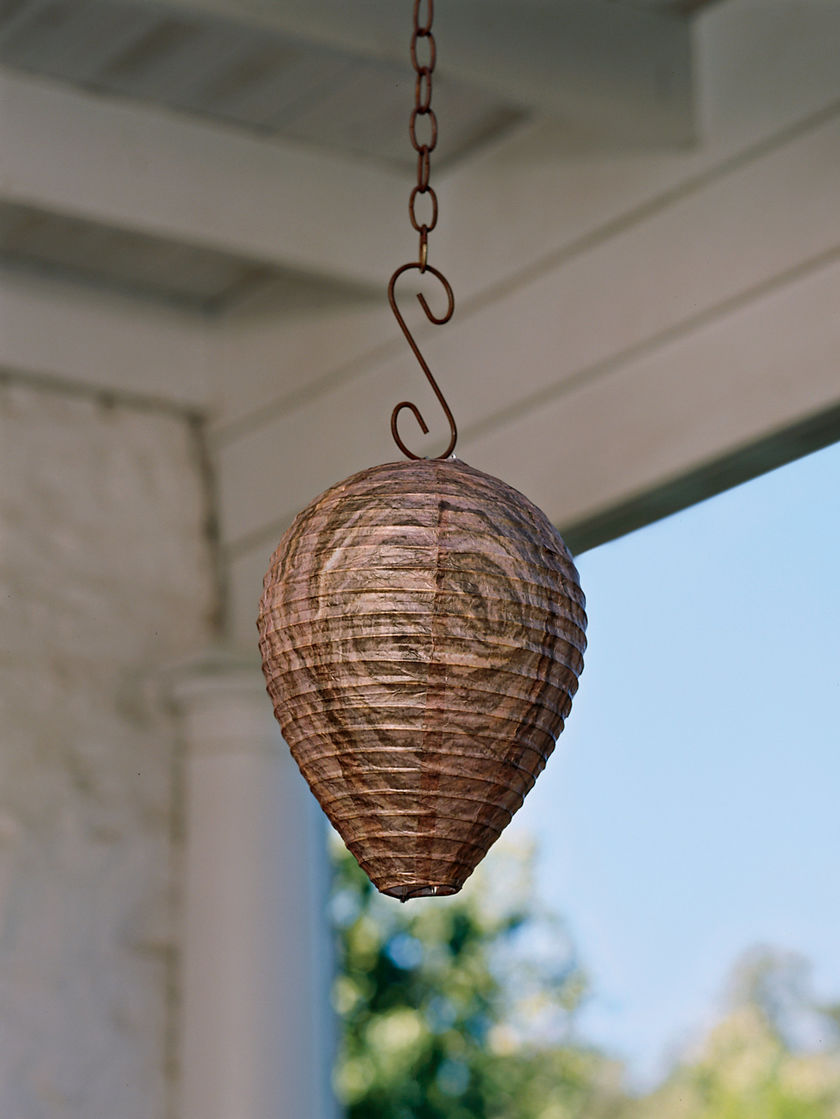
Placing a commercial wasp nest near your eating area will generally deter wasps since they are very territorial and will not re-use an empty nest. However placing the fake nest should be done early in the season before the nests have been established. Placing the nest later in the season will have no effect.
Nest Removal:
- Wasps will abandon their nest in the winter, therefore try to delay removing the nest until November or December.
- If the nest must be removed when the wasps are active, it should be done in the evening when it is cooler and wasps are least active.
- Nest removal, by placing a garbage bag around the nest and then closing the opening, can be dangerous and use extreme caution because of the risk of attack by a large group of wasps.
- Although a homeowner (with enough protection) can remove a nest, professional help is recommended.
Ground wasp or yellow jacket:
- have a smooth, bright yellow and black body with a well-defined wast and thin legs.
- Are much more aggresive than honey bees and will chase you away from the hive.
- Are carnivores in spring and early summer feeding mostly on insects to provide protein for developing larvae in the colony
- Their diet changes to include more sugars later into summer
- In the fall, as food is more scarce, they become scavengers visiting garbage cans and picnic areas.
- Nest underground in old vole or mouse holes.
- Large nests may pose a substantial hazard.
- Avoid walking barefoot on lawns or other grassy areas, especially in late summer when wasps are more abundant and active.
Prevention and Control:
- Since ground wasps and yellow jackets hunt for high-protein food like insects for their larvae, make sure you don't leave moist pet food or picnic leftovers in the open.
- Place ground wasp and yellow jacket traps in spring and early summer around the perimeter of your outdoor seating and eating area.


- Yellow jacket traps are commercially available

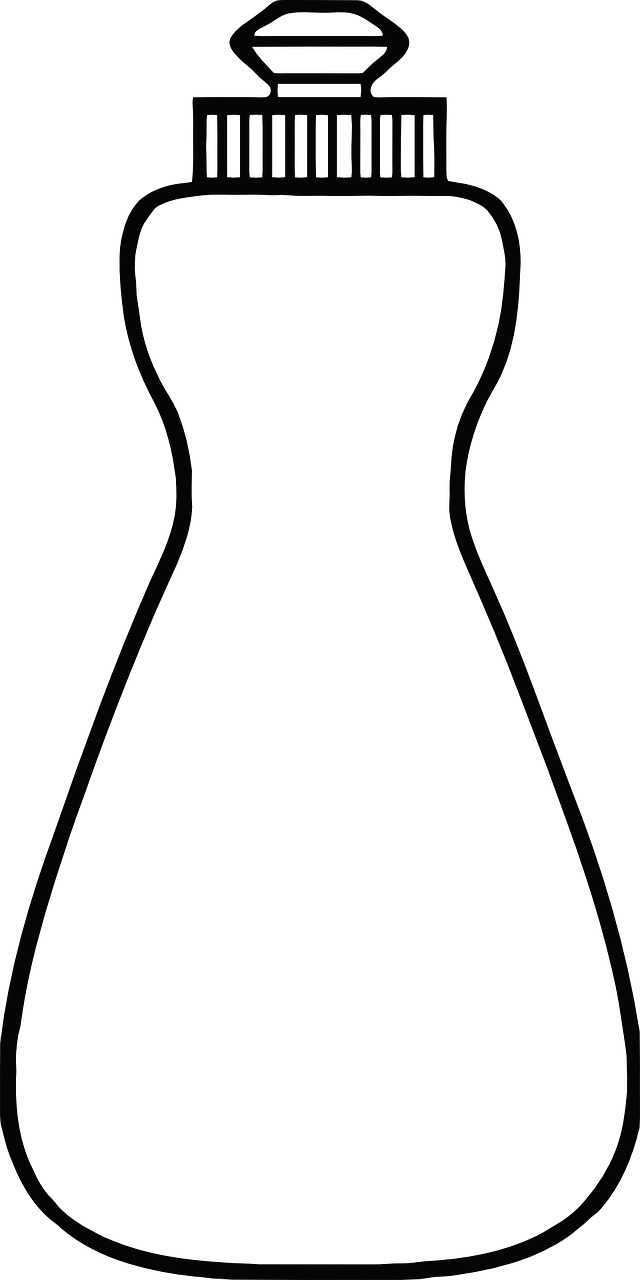

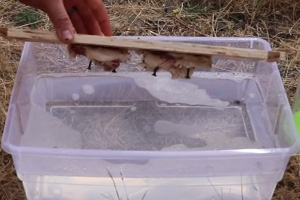

- Home made versions work well if you need to reduce the yellow jacket population substantially.
- Locate the nest and pour a soap and water solution into the entrance of the nest at night when they are less active.
Bumblebees
- Generally nest underground
- Very large compared to a honey bee or yellow jacket
- Bumblebee conlonies generally do not exceed 100 members
Control:
- Locate the hive.
- Spray the hive with water several times during the day to discourage their return.
- They may chase you but not in a cluster like yellow jackets.
For more pest control tips:






Post a comment